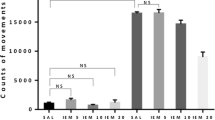Summary
The anticataleptic effects of non-competitive and competitive NMDA antagonists as well as those of an agonist at the allosteric glycine binding site of the NMDA receptor were tested in the catalepsy model. Some of these drugs were further tested in a reaction time task demanding rapid locomotor initiation. The results show that the non-competitive NMDA antagonists dizocilpine and memantine as well as the competitive antagonists CGP 39551, CGP 37849 and CPPene antagonized dopamine D2 receptor mediated catalepsy induced by haloperidol. D-cycloserine, a partial glycine agonist per se had no effects, but it enhanced the anticataleptic effects of dizocilpine when coadministered. However, the effects of CGP 37849 were abolished. Dopamine D1 receptor mediated catalepsy induced by SCH 23390 was antagonized by dizocilpine, memantine, CPPene, but not by CGP 37849. In the reaction time task dizocilpine, memantine and CGP 37849 were tested for their anti-akinetic and anti-bradykinetic potencies. All these compounds improved haloperidolinduced slowing of reaction time. However, they acted differentially on haloperidol-induced slowing of movement execution and decreased initial acceleration. Thus, antagonists at the NMDA receptor may have a therapeutic potential in the treatment of Parkinson's disease. Their potency can be manipulated specifically at the glycine binding site.
Similar content being viewed by others
References
Amalric M, Koob GF (1987) J Neurosci 7/7: 2129–2134
Bormann J (1989) Eur J Pharmacol 166: 591–592
Carlsson M, Carlsson A (1990) Trends Neurosci 13/7:272–280
Clineschmidt BV, Martin GE, Bunting PR, Papp NL (1982) Drug Dev Res 2: 135–145
Danysz W, Wroblewski JT (1989) Neurosci Res Comm 5: 9–18
Elliott PJ, Close SP, Walsh DM, Hayes AG, Marriott AS (1990) J Neural Transm 2: 91–100
Hallett M (1990) Rev Neurol (Paris) 146/10: 585–590
Hauber W, Schmidt WJ (1989) J Neural Transm 78: 29–41
Hauber W (1990) Experientia 46: 1083–1088
Hauber W, Schmidt WJ (1990) Behav Brain Res 41: 161–166
Hölscher C, Schmidt WJ (1991) In: Elsner N, Penzlin H (eds) Synapse — Transmission modulation. Proceedings of the 19th Göttingen Neurobiology Conference, Göttingen 1991, Thieme, Stuttgart New York (Abstr 450)
Hood WF, Compton RP, Monhan JB (1989) Neurosci Lett 98: 91–95
Imperato A, Scrocco MG, Bacchi S, Angelucci L (1990a) Eur J Pharmacol 187: 555–556
Imperato A, Honore T, Jensen LH (1990b) Brain Res 530: 223–228
Johnson JW, Ascher P (1987) Nature 325: 529
Keseberg U, Bubser M, Schmidt WJ (1991) In: Elsner N, Penzlin H (eds) Synapse — Transmission modulation. Proceedings of the 19th Göttingen Neurobiology Conference, Göttingen 1991, Thieme, Stuttgart New York (Abstr 448)
Kornhuber J, Bormann J, Retz W, Hübers M, Riederer P (1989) Eur J Pharmacol 166: 589–590
Liljequist S, Ossowska K, Grabowska-Andén M, Andén N-E (1991) Eur J Pharmacol 195: 55–61
Mehta AK, Ticku MK (1990) Life Sci 46: 37–42
Monaghan DT, Olverman HJ, Nguyen L, Watkins JC, Cotman CW (1988) Proc Natl Acad Sci USA 85: 9836
Morris RGM, Anderson E, Lynch GS, Baudry M (1986) Nature 319: 774
Scheel-Krüger J (1983) In: Enna EJ (ed) Humana Press Clifton, pp 215–256
Schmidt WJ (1986) Psychopharmacology 90: 123–130
Schmidt WJ, Bischoff C (1988) Psychopharmacology 96: 51
Schmidt WJ, Bury D (1988) Life Sci 43/6: 545–549
Schmidt WJ, Bubser M (1989) Pharmacol Biochem Behav 32: 621–623
Schmidt WJ, Bubser M, Hauber W (1990) Trends Neurosci 13/2: 46
Skjoldager P, Fowler SC (1988) Psychopharmacology 96: 21–28
Stelmach GE, Worringham CJ (1988) Neuropsychologia 26: 93–103
Tiedtke PI, Bischoff C, Schmidt WJ (1990) J Neural Transm 81: 173–182
Watson GB, Bolanowski MA, Boganoff MP, Deppeler CL, Lanthorn TH (1990) Brain Res 510: 158–160
Wierzbicka MM, Wiegner AW, Logigian EL, Young RR (1991) J Neurol Neurosurg Psychiatry 54: 210–216
Wong EHF, Knight AR, Ransom R (1987) Eur J Pharmacol 142: 487–488
Author information
Authors and Affiliations
Rights and permissions
About this article
Cite this article
Schmidt, W.J., Zadow, B., Kretschmer, B.D. et al. Anticataleptic potencies of glutamate-antagonists. Amino Acids 1, 225–237 (1991). https://doi.org/10.1007/BF00806920
Issue Date:
DOI: https://doi.org/10.1007/BF00806920




